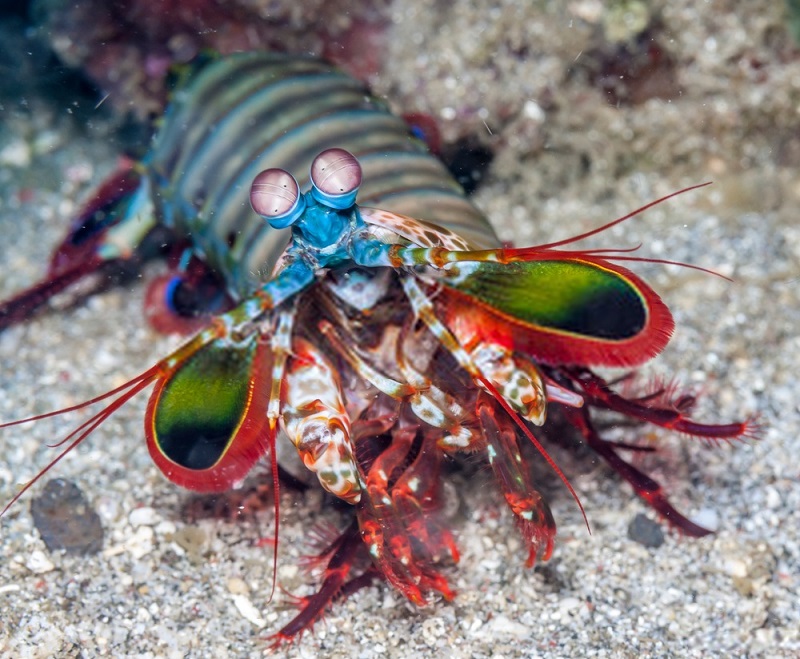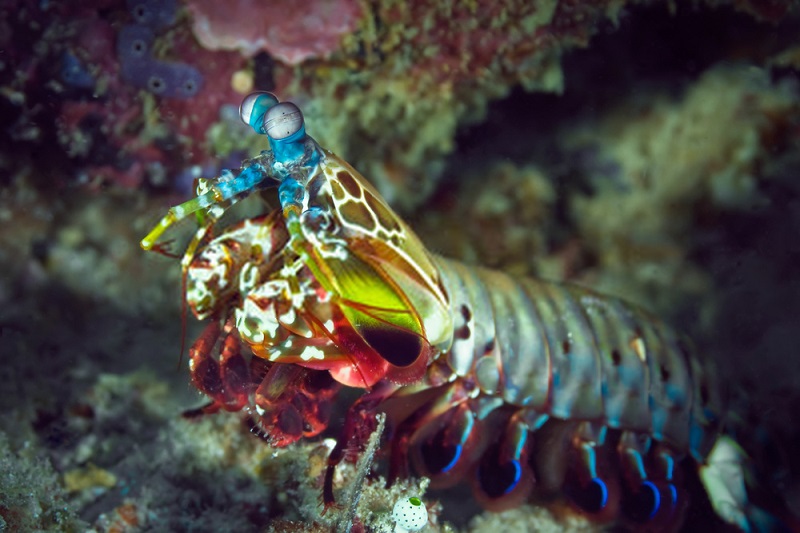
| Kingdom | Animalia |
| Phylum | Arthropoda / subphylum Crustacea |
| Class | Malacostraca |
| Order | Stomatopoda |
| Family | Many |
| Genus | Many |
| Species | 451 different Species |
| Niche | Marine Predator |
| Size | 4-15 in (10-38 cm) |
| Weight | 0.4-3.2 oz (12-90 g) |
| Lifespan | 3-6 years (up to 20 years in some species!) |
| Social Structure | Typically, mated pairs live together for life |
| Conservation Status | Unknown |
| Preferred Habitat | Sediment or Coral Reef Burrows |
| Average Clutch Size | Hundreds of Eggs |
| Main Food Source | Fish, snails, crabs, oysters |
| Predators | Humans, sometimes large fish, sharks, and rays |
The Basics
Mantis shrimp are an extremely fascinating group of shrimp species. While most shrimp species feed on tiny organisms or scavenge on dead organisms, mantis shrimp are true predators. Mantis shrimp have forelimbs that have been modified to spear or stun their prey, and mantis shrimp are broken into subgroups based on this feature.
“Smashers” use these forelimbs as clubs. Since these modified forelimbs have a massive power behind them, they are able to create forces unequaled in the animal world. The club can reach speeds of nearly 50 mph in a fraction of a second. This creates a force of over 1,500 newtons or the same as a 340-pound object falling directly onto the prey! But, the acceleration of the club also creates a sonic wave, which smashes into the prey shortly after the actual club. This gives Smashers a “1-2 punch” that can cripple much larger prey.

By comparison, “Spearers” have sharp points on their limbs that they use to impale small fish and other prey items. Spearers can also strike with amazing speed and precision. Unlike Smashers, Spearers tend to live in soft substrates such as sand. Here, they wait for an unfortunate fish to swim by, which they then impale at lightning speed.
Most mantis shrimp also display beautiful and striking coloration, which can serve as both camouflage and communication. Some species are darkly or drably colored, which helps them blend into the seafloor. Others, like the peacock mantis shrimp, use bright warning coloration to scare off any potential predators. If that doesn’t work, their powerful strike can injure or scare many potential predators away.
Interesting Insights from the Mantis Shrimp!
As if the Mantis Shrimp wasn’t cool enough, studying these shrimp can give us many insights into bigger biological concepts. Check it out!
Hunting Adaptations
The two different types of mantis shrimp – Smashers and Spearers – show us just how adaptable crustaceans can be. Though mantis shrimp all evolved from a common ancestor nearly 200 million years ago, they have very different uses for their front limbs. Smashers simply use the direct force of their mantis-like front legs to strike prey, while Spearers have adapted sharp barbs on their limbs to impale and capture their prey.

As such, the two different groups tend to focus on different kinds of prey. Spearers tend to focus on soft, fleshy fish. Smashers take on more formidable prey, such as other crustaceans, snails, and oysters. Their club-like limbs can break apart the shells of these animals so they can get to the nutrients inside.
This difference in usage and prey type may have been the driving factor that started the process of speciation in this group. Today, there are over 450 different species of mantis shrimp, that live in coastal regions all over the globe.
Compound Eyes
In addition to their incredible weapon-like appendages, mantis shrimp also have another adaptation that makes them incredible predators. Mantis shrimp, like many other arthropods, have compound eyes. Compound eyes function similarly to human eyes, though they are constructed very differently. Instead of a single lens that funnels light onto a retina, these receptor cells of these eyes are right at the surface.

However, mantis shrimp have the most complex and functional compound eyes of any animal studied, ever. While humans have 3 types of cells that can detect different colors and wavelengths of light, mantis shrimp have up to 16 different types of cell in their eyes. That means mantis shrimp can likely see a number of wavelengths that are far beyond human perception. This means that mantis shrimp can detect both infrared light and ultraviolet light, neither of which humans can see.
This amazing ability also gives us clues as to why mantis shrimp are often brightly colored.
Coloration as Communication
Many animals communicate through their coloration. For example, bees and many insects display “warning coloration”, so other animals can recognize them as dangerous. Other animals, like peacocks, have developed colorful coloration schemes to attract mates. Over time, more colorful mates are selected, which leads to very colorful males or females.

Mantis shrimp seem to be using a little of both. Their bright coloration warns would-be predators that they pack a punch. However, researchers have also found that mantis shrimp can attract mates and communicate with other mantis shrimp via the coloration that they show. Some species even have biofluorescence, which they can use to signal to their mates or other shrimp invading their space.
With their amazing compound eyes, these shrimp have the ability to see patterns and colors of light not visible to the human eye. While we know that these shrimp communicate using colorful signals, the exact mechanisms and processes are not fully understood. This is mostly because we need complex scientific instruments to measure what light mantis shrimp display and how they process light signals.
